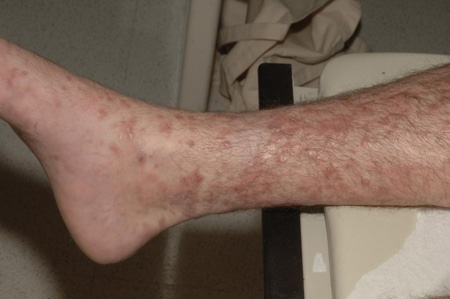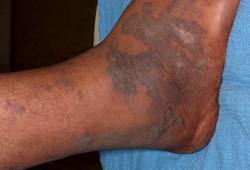History and exam
Key diagnostic factors
common
age >50 years
male sex
All epidemiologic forms of KS have a predilection for males. In 2022, the age-standardized incidence rates of KS were estimated to be 0.6 cases per 100,000 population in men and 0.3 cases per 100,000 in women.[10]
geographic location: central Africa or the Mediterranean
Occurs worldwide. Prior to the AIDS epidemic, incidence rates for endemic KS were greater for the Democratic Republic of Congo, Uganda, Tanzania, and Cameroon (>6 per 1000 person-years) than for southern or north Africa (≤2 per 1000 person-years).[21]
Classic (sporadic) KS has the highest incidence rates in Mediterranean countries.[4]
HIV infection
People with HIV are approximately 500 times more likely to be diagnosed with KS than the general population.[11][12]
HIV-associated usually KS arises in people with low CD4+ T-cell counts and high HIV viral load. Effective antiretroviral therapy (ART) reduces the risk of developing KS.
KS may sometimes occur in people with well-controlled HIV, most often in older patients.[2]
human herpesvirus-8 (HHV-8, also known as Kaposi sarcoma-associated herpesvirus [KSHV]) infection
Existing HHV-8 infection is necessary for the development of KS.
Individuals with HHV-8-related diseases, such as multicentric Castleman disease and primary effusion lymphoma (PEL), are at risk for developing concomitant KS.[26]
immunosuppression
Iatrogenic KS may be observed in patients receiving immunosuppressive therapy, particularly organ transplant recipients.[3]
In the US, the incidence of KS among transplant recipients is reported to be between 8.8 and 12.4 per 100,000 recipients.[19][20] The incidence of iatrogenic (transplant-related) KS varies with different ethnic and geographic regions.[17][18][19]
skin lesion
Lesions are multifocal, asymmetrically distributed, and nonpruritic. They vary in size (ranging from several millimeters to centimeters in diameter) and color (pink, red, purple, brown, or blue). Cutaneous lesions may be difficult to distinguish in dark-skinned people. They can be papular, nodular, plaque-like, bullous-like, or fungating with skin ulceration and secondary infection.[3] Longstanding lesions may become indurated (woody) and hyperkeratotic.[Figure caption and citation for the preceding image starts]: Multiple pink-purple Kaposi sarcoma nodules on the lower extremityFrom the collection of Dr Bruce J. Dezube; used with permission [Citation ends]. [Figure caption and citation for the preceding image starts]: Kaposi sarcoma cutaneous purple-brown plaque on the footFrom the collection of Dr Bruce J. Dezube; used with permission [Citation ends].
[Figure caption and citation for the preceding image starts]: Kaposi sarcoma cutaneous purple-brown plaque on the footFrom the collection of Dr Bruce J. Dezube; used with permission [Citation ends].
oral lesion
Oral KS frequently affects the hard palate, gingiva, and dorsum of the tongue.
Approximately 23% of patients with HIV-associated KS may present with oral lesions; global prevalence of oral lesions in patients with HIV with KS has been estimated to be 5%.[44][45]
Oral lesions can present as macules, papules, nodules, and exophytic masses of varying size and color. Advanced lesions may become ulcerated from masticatory trauma and secondary infection.
lymphadenopathy
Involvement of the lymph nodes by KS may be generalized and result in small, hard lymph nodes or massive lymphadenopathy.
lymphedema
May be painful in the legs, genitalia, and face, out of proportion to the extent of disease, and can mask underlying KS.
Other diagnostic factors
uncommon
weight loss
May occur from gastrointestinal tract involvement or the underlying condition (e.g., HIV infection).
abdominal pain
KS of the gastrointestinal tract can cause nonspecific abdominal pain.
gastrointestinal (GI) bleeding
KS of the GI tract can cause upper or lower GI tract bleeding.
diarrhea
KS of the gastrointestinal tract can infrequently cause diarrhea.
dyspnea
Pulmonary KS can present with shortness of breath.
hemoptysis
KS-related bleeding of the lower respiratory tract can result in hemoptysis.
chest pain
Pulmonary KS can present with nonspecific chest pain.
fever
KS of any organ may be accompanied by pyrexia.
Risk factors
strong
male sex
All epidemiologic forms of KS have a predilection for males.
In 2022, the age-standardized incidence rates of KS were estimated to be 0.6 cases per 100,000 population in men and 0.3 cases per 100,000 in women.[10]
HIV infection
immunosuppressive therapy
Iatrogenic KS may be observed in patients receiving immunosuppressive therapy, particularly organ transplant recipients.[3]
In the US, the incidence of KS among transplant recipients is reported to be between 8.8 and 12.4 per 100,000 recipients.[19][20] The incidence of iatrogenic (transplant-related) KS varies with different ethnic and geographic regions.[17][18][19]
human herpesvirus-8 (HHV-8, also known as Kaposi sarcoma-associated herpesvirus [KSHV]) infection
Existing human herpesvirus-8 (HHV-8) infection is necessary for the development of KS.
Individuals with HHV-8-related diseases, such as multicentric Castleman disease and primary effusion lymphoma (PEL), are at risk for developing concomitant KS.[26]
central African ethnicity
Prior to the AIDS epidemic, incidence rates for endemic KS were greater for the Democratic Republic of Congo, Uganda, Tanzania, and Cameroon (>6 per 1000 person-years) than for southern or north Africa (≤2 per 1000 person-years).[21]
weak
drug abuse
Among people with HIV, those with intravenous drug use, noninjection drug use, and alcohol use disorder are more likely to have KS.[27]
A subsequent study found no association between use of recreational drugs (amphetamines, amyl nitrate [poppers], cocaine, cannabis) and risk for KS in HIV- and human herpesvirus-8 (HHV-8)-coinfected men who have sex with men.[28]
Jewish ethnicity
Older men of Jewish descent are at risk of developing KS.[16]
Mediterranean ethnicity
age <5 years or >50 years
men who have sex with men
Black American ethnicity
KS is more common in black Americans than white Americans (age-adjusted incidence rate 1.19 vs. 0.49 per 100,000, respectively; 2008-2012 data). Black Americans are more likely to be diagnosed at a younger age and experience higher mortality rates.[6][7]
Data from 1998 to 2012 indicate decreasing incidence of KS in the white American population; however, increasing incidence is seen in the black American population from the mid-2000s.[7]
Certain subpopulations have been identified with significant increases (e.g., young, non-Hispanic black men in southern US regions).[8]
Use of this content is subject to our disclaimer